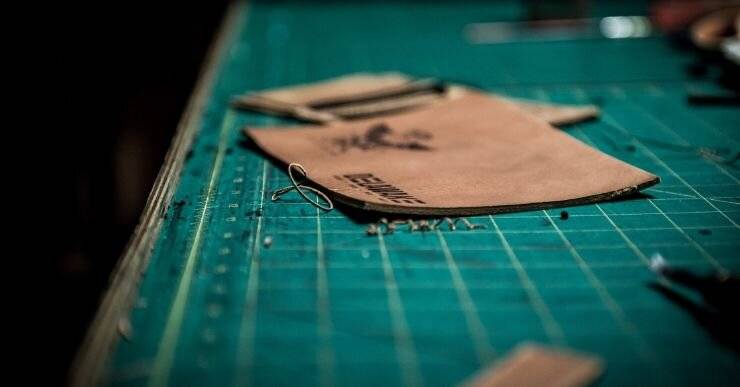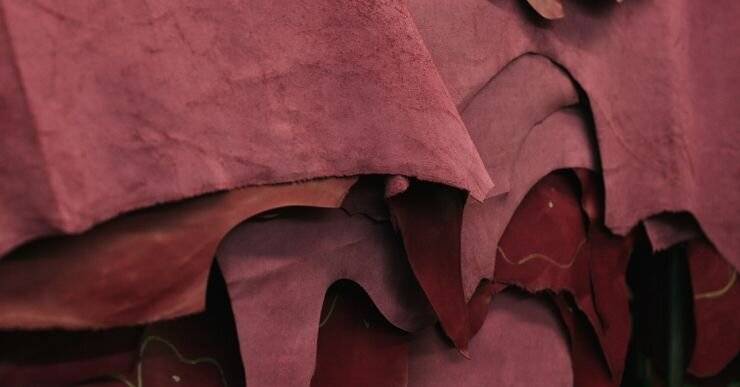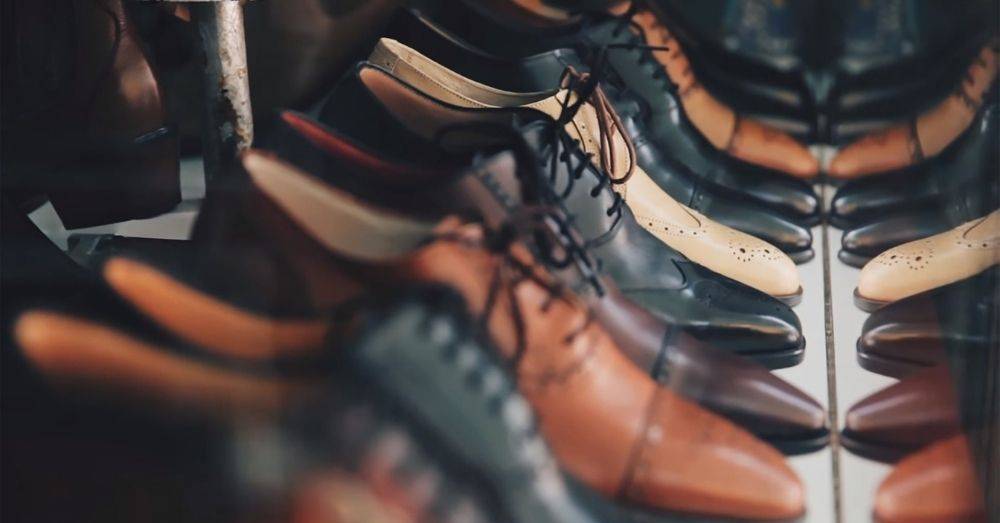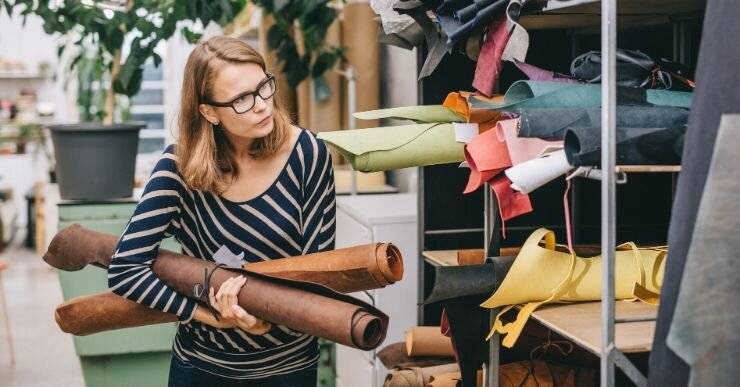Leather manufacturing: An in-depth look beyond the skin
Leather manufacturing has a long history, an interesting future, and is still a relevant material today. This article fully explores the leather industry.
Team Katana

Leather Manufacturing still plays an important role in the manufacturing industry, from producing leather to using leather to make your products. In this article, we’re going to take an in-depth look into the industry, real leather, faux leather, and the tools you can use to reduce the amount of waste you produce.
In the caveman days, innovation wasn’t making a knife that makes toast as you cut your bread. Innovation was a means of survival.
When they had limited resources and the ultimate risks, the practice of lean inventory was essential – long before people even knew what this method was.
For example, one thing cavemen would do after a hunt is to utilize all the animal’s parts and not let anything go to waste.
And thus, began leather manufacturing.
A raw material so sturdy and reliable, it still plays an important role in the manufacturing industry today.
However, as already mentioned, we don’t live in the caves anymore (plus its hyperbole anyway), and some would even argue that the use of animal-based leather is redundant as there are alternative sources to use when making leather.
So, as you can imagine, leather manufacturing can be a minefield of ethics as consumers and manufacturers are now opting for cruelty-free leather.
That’s why we’re going to take an in-depth look at the leather manufacturing industry, how leather goods manufacturing is carried out, and the software you can use to help you manage the material.
So, without further ado, let’s get into it.
Get control of your leather materials. Don’t lose track of another item with manufacturing ERP software purpose-built for manufacturers. Request a demo and see it for yourself.
What is leather manufacturing?

Leather manufacturing is the process of converting raw animal skin into leather through three sub-processes:
- Preparatory stages
- Tanning
- Crusting
However, the operations the hide undergoes (that could be anywhere from 35 to 55 different operations) all depend on what type of leather a manufacturer is producing.
Leather manufacturing is a by-product of the meat and dairy industries, and leather can come from any animal.
But, the most popular type of skin used in the leather manufacturing industry is bovine (ox, cow, calf, and buffalo skin), which accounts for 64% of leather.
Leather is traded internationally and comes in different conditions: fresh, wet salted, pickled, sun-dried, crust, wet blue, and finished.
The history of leather manufacturing is a long one.
Leather has been manufactured for thousands of years, by extracting water from bark, wood or leaves, to preserve an animal’s skin from decay.
According to experts, the oldest tanneries, found in Egypt, date back to over 5,000 years.
And since then, it’s now estimated that there are 9,000 tanneries worldwide, and the annual area of leather produced is 19,000 million square feet, that’s around 2 million square feet per tannery.
We haven’t touched on faux leather, but we will further in the article. For now, let’s investigate the leather manufacturing process.
What is the leather manufacturing process?

As quickly touched upon in the previous chapter, the leather manufacturing process is long and complicated.
And because of this, manufacturers (due to the supply and the time constraints) use a batch manufacturing process to fulfill manufacturing orders.
To make leather, here are the steps a manufacturer would need to follow:
Preservation
After slaughtering the animal, the skin is preserved to survive the journey to the tannery by drying, salting, or freezing.
Beamhouse operations
At this stage, the manufacturer begins prepping the hides for tanning. While at this stage, the skin goes through:
- Soaking
- Liming
- Fleshing
- Splitting
- Pickling
Once the hide is ready, it can then go through the leather manufacturing process of tanning.
Tanning
At this step, the tannins (chemicals) are absorbed by the skins to turn them into leather.
Neutralizing
The leather manufacturer begins neutralizing the acids left behind from tanning.
Withering
Any residual water is squeezed out from the wet skins through metal rolls.
Finally, the material passes through its final steps.
Sorting
The leather goes through quality checks and any necessary fixes, or alterations take place at this stage.
This will consist of steps such as:
- Shaving
- Dyeing
- Drying
- Softening
- Finish
After all this, the final quality check takes place.
If you’re more of a visual learner, let us wheel out the hypothetical TV and trolley from your school years, to share this video on leather manufacturing with you:
However, this is mostly relevant for the animal by-product of leather making, but what about faux leather?
Leather manufacturing with cruelty-free material

The traditional leather manufacturing process is arguably a grizzly affair, and a lot of people may even consider it barbaric.
Luckily, as mentioned before, we have innovated beyond innovation, and now know that we’re able to use other sources of material when manufacturing leather.
Artificial leather (synthetic leather, faux leather, vegan leather, or pleather) is the go-to for manufacturers looking for a cruelty-free alternative.
One of the earliest known faux leathers was Presstoff.
During WW2, leather was rationed in Germany, and Presstoff – a layered and treated paper pulp – was used instead to produce items that were normally made with leather.
Since then, innovative manufacturers have been producing many different types of faux leather from all sorts of sources, with the most popular being plastic.
“Plastic!?” you might be screaming.
Yes, it is plastic, mainly PU leather and PVC leather, which is an issue since it’s a lot less degradable than actual leather.
However, don’t fret, as there are a ton of other animal-free sources for leather manufacturing that are also eco-friendly such as:
- Paper
- Waxed cotton
- Apple fibers
- Tree bark and cork
- Pineapple
- Mushroom
- Teak leaves
But you might still be confused, “What type of leather should I be using?” and honestly, it all depends on the type of leather that you need for your products.
Do you need something strong and durable? Or are you using leather product manufacturing purely for its aesthetics?
Pro tip:
As a leather manufacturer, you need a tool that helps you handle your manufacturing operations and meet deadlines. That’s why it’s essential to find production scheduling software to assist you in managing your business.
Leather goods manufacturing

Let’s pretend you want to start a business where using leather goods manufacturing is an option, or you’re just curious as to what products might use leather.
Well, a manufacturer may use leather when making:
- Upholstery
- Bags
- Gloves
- Garments
- Covers
- Shoes
- Holsters and sheaths
- Saddles
- Decorative items
Most products you could think of can have leather incorporated into them somehow.
As we briefly touched upon at the end of the last chapter, you could use the leather goods you’re manufacturing as an indicator of what type of leather you could use.
If you’re making shoes, you’ll need tough, resilient leather, and using real leather would extend the product’s life cycle.
But, if you’re designing decorative items for keychains, faux leather is certainly a fine alternative.
Whatever it is that you’re doing, make sure you’re aware of how to start a leather business, and you’re doing everything in your power to reduce your carbon footprint as, unfortunately, leather manufacturing isn’t great for the environment due to:
- The use of polluting chemicals during the tanning process
- The air pollution generated from making the leather (hydrogen sulfide from dehairing, and ammonia from deliming, and the solvent vapors, etc.)
This is why it’s important for anyone practicing leather manufacturing to find a tool that can help them track their raw materials, monitor their operations, and handle their production scheduling.
Material requirements planning software
Katana material requirements planning software helps 1000s manufacturers maintain control of raw materials and final products in real time. Find out how by reading here.
ERP manufacturing software for leather manufacturing

It doesn’t matter if you’re a leather manufacturer with a factory producing the raw material or a team of designers using leather for your finished goods, Katana’s cloud based manufacturing system is an all-in-one solution to help manufacturers get more control over their business.
Katana is a piece of software helping manufacturers handle their operations by giving them access to:
A smart auto-booking engine
Katana’s smart auto-booking engine automatically distributes your raw materials to manufacturing orders and finished goods to any open sale orders.
It doesn’t matter if you’re a manufacturer converting hides into leather or a designer making a leather jacket. Katana will track your inventory movement and your manufacturing operations/processes as you make your final product based on your bill of materials.
Raw material and finished goods inventory management
Inventory management is important for any business. However, raw material inventory management is essential for a leather manufacturer, and unfortunately, there aren’t many tools that help you in this area.
This is not the case with cloud inventory software. Katana allows you to track your raw material levels in real-time, so you can easily see when inventory is running low or how much you’re wasting, so you can implement a solution to become a leather manufacturer who practices green manufacturing.
Priority-based production planning
Katana’s nifty drag-and-drop system allows a leather manufacturer to effortlessly reorganize their schedule.
Katana automatically schedules production in the order MO’s are created. However, should a VIP order come through, or you’re treating hide differently, and a different workflow would be more efficient, simply reorder the master production schedule, and Katana will rearrange everything for you (even redistributing your allocated materials).

CASE STUDY
Paper Republic is a leather manufacturing business that produces leather journals and accessories for those who want a more durable product for saving their scribbles.
Founder Jérôme Bacquias adopted Katana into their business and had this to say, “Besides improving day-to-day operations, finished goods and raw material inventory management, Katana has also helped us decrease our lead production time by 35% through improved order production and sourcing planning.”
But not only that, Katana helped Paper Republic:
- Improve production planning by 60%
- Differentiate between batch and bespoke products from custom leather manufacturing orders
- Improve inventory accuracy by 29%
Learn more about how Katana helped Paper Republic with leather manufacturing
Conclusion

Now you know the history of leather manufacturing, the different sources, and the benefits of using a certain material.
You can now begin to make informed decisions when looking into leather or making a product that uses leather.
We can argue all day if products should be made from real or faux leather. But whichever you determine to be the best for you, the one unquestionable similarity between the two materials is how harmful the waste is to the environment.
This is when it’s crucial to find software that can help you carefully and easily track your raw material inventory in real-time.
And, it doesn’t matter if you’re a massive company producing leather or a band of designers making handbags, Katana is the perfect tool for helping you get your manufacturing operations under control.
Using Katana’s task lists, you can easily monitor your processes, the time it takes to complete a process, or if a process is finished.
So, from tanning to dyeing or simply putting the finishing touches on a leather jacket, Katana’s got you covered.
Why not check it out for yourself? Reach out to our sales team today and request a demo.
That’s it for today! We hope that you enjoyed this article, and if you have any questions or want to know more about how Katana can help a leather manufacturer, please do not hesitate to drop a comment below or message us on social media.
And until next time, happy manufacturing!
Team Katana
Table of contents
Get inventory trends, news, and tips every month
Get visibility over your sales and stock
Wave goodbye to uncertainty by using Katana Cloud Inventory for total inventory control
